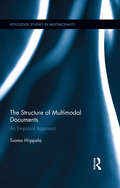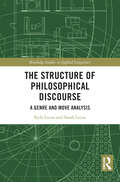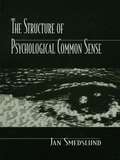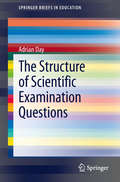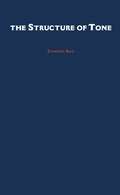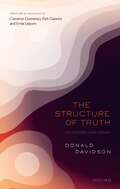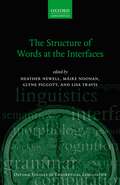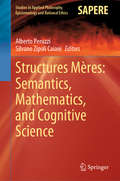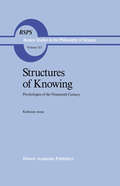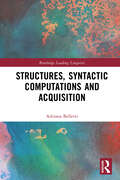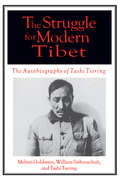- Table View
- List View
The Structure of Multimodal Documents: An Empirical Approach (Routledge Studies in Multimodality)
by Tuomo HiippalaThis book develops a new framework for describing the structure of multimodal documents: how language, image, layout and other modes of communication work together to convey meaning. Building on recent research in multimodal analysis, functional linguistics and information design, the book examines the textual, visual, and spatial aspects of page-based multimodal documents and employs an analytical model to describe and interpret their structure using the concepts of semiotic modes, medium and genre. To demonstrate and test this approach, the study performs a systematic, longitudinal analysis of a corpus of multimodal documents within a single genre: an extensively annotated corpus of tourist brochures produced between 1967-2008. The book provides multimodal discourse analysts with methodological tools to draw empirically-based conclusions about multimodal documents, and will be a valuable resource for researchers planning to develop and study multimodal corpora.
The Structure of Multimodal Documents: An Empirical Approach (Routledge Studies in Multimodality)
by Tuomo HiippalaThis book develops a new framework for describing the structure of multimodal documents: how language, image, layout and other modes of communication work together to convey meaning. Building on recent research in multimodal analysis, functional linguistics and information design, the book examines the textual, visual, and spatial aspects of page-based multimodal documents and employs an analytical model to describe and interpret their structure using the concepts of semiotic modes, medium and genre. To demonstrate and test this approach, the study performs a systematic, longitudinal analysis of a corpus of multimodal documents within a single genre: an extensively annotated corpus of tourist brochures produced between 1967-2008. The book provides multimodal discourse analysts with methodological tools to draw empirically-based conclusions about multimodal documents, and will be a valuable resource for researchers planning to develop and study multimodal corpora.
The Structure of Philosophical Discourse: A Genre and Move Analysis (Routledge Studies in Applied Linguistics)
by Kyle Lucas Sarah LucasThis book builds on existing work in genre analysis and move analysis in English for Specific Purposes (ESP) and applies this new framework to academic philosophical discourse, offering new insights into how ESP traditions can elucidate shifts in language conventions across disciplinary contexts.The volume begins by surveying the state of the art in English for Specific Purposes and genre theory, as well as other genre theory paradigms before turning the focus on move analysis. Lucas and Lucas seek to maximize the potential of move analysis to precisely operationalize functional units of discourse by implementing a cognitive theory of genre grounded in frame semantics. Using the case of academic research articles in philosophy, the authors demonstrate how this framework can reveal distinctive dimensions unique to philosophical discourse and, in turn, how such an approach might be applied more broadly to examine nuances in language across disciplines and inform ESP research in the future.This book will appeal to students and researchers in English for Specific Purposes, discourse analysis, academic writing, applied linguistics, and rhetoric and composition.
The Structure of Philosophical Discourse: A Genre and Move Analysis (Routledge Studies in Applied Linguistics)
by Kyle Lucas Sarah LucasThis book builds on existing work in genre analysis and move analysis in English for Specific Purposes (ESP) and applies this new framework to academic philosophical discourse, offering new insights into how ESP traditions can elucidate shifts in language conventions across disciplinary contexts.The volume begins by surveying the state of the art in English for Specific Purposes and genre theory, as well as other genre theory paradigms before turning the focus on move analysis. Lucas and Lucas seek to maximize the potential of move analysis to precisely operationalize functional units of discourse by implementing a cognitive theory of genre grounded in frame semantics. Using the case of academic research articles in philosophy, the authors demonstrate how this framework can reveal distinctive dimensions unique to philosophical discourse and, in turn, how such an approach might be applied more broadly to examine nuances in language across disciplines and inform ESP research in the future.This book will appeal to students and researchers in English for Specific Purposes, discourse analysis, academic writing, applied linguistics, and rhetoric and composition.
The Structure of Psychological Common Sense
by Jan SmedslundPsychologic is a formal system and relationship within which psychological processes are defined. The language people ordinarily use to formulate, think, and talk about psychological phenomena is organized by Jan Smedslund into a set of propositions aimed at identifying the generalities which underlie human behavior. In this way, psychologic illuminates the conceptual system of psychology embedded in ordinary language. This book continues Professor Smedslund's search for stable theoretical structures to explain the meanings that are part of all psychological investigation.
The Structure of Psychological Common Sense
by Jan SmedslundPsychologic is a formal system and relationship within which psychological processes are defined. The language people ordinarily use to formulate, think, and talk about psychological phenomena is organized by Jan Smedslund into a set of propositions aimed at identifying the generalities which underlie human behavior. In this way, psychologic illuminates the conceptual system of psychology embedded in ordinary language. This book continues Professor Smedslund's search for stable theoretical structures to explain the meanings that are part of all psychological investigation.
The Structure of Scientific Examination Questions (SpringerBriefs in Education)
by Adrian DayThis book shows how Systemic Functional Linguistics may be used to explore and explain the grammar of scientific examination questions. The author outlines the key elements of this theory and identifies problematical structures that affect the linguistic validity of such education assessment questions. This book also shows how examination questions may provide insight into the relationship between teaching and language in science.Do candidates give an incorrect answer because they do not understand the topic or because they do not understand the language by which the question is framed? This book shows how the analysis of scientific examination questions can answer this question.These chapters show how contemporary linguistics can inform the assessment of science and address topics including: the role of images, lexicography, the morphology of sentences, semantic discontinuity and the active reader.An example question is used throughout the text to illustrate the theories and each chapter has its own useful summary, making it a very readable work.
The Structure of Tone
by Zhiming BaoThis book argues a fresh theory about the structure of tone. Bao investigates a wide range of tone sandhi data from various Chinese dialects and other Asian tone languages, providing empirical support for his proposal that tone is a formal entity which consists of register and contour. Bao establishes a clear typological distinction between register tone languages and contour tone languages whose contour tones have a more complex structure.
The Structure of Truth
by Donald DavidsonDonald Davidson was one of the most famous and influential philosophers of the twentieth century. The Structure of Truth presents his 1970 Locke Lectures in print for the first time. They comprise an invaluable historical document which illuminates how Davidson was thinking about the theory of meaning, the role of a truth theory therein, the ontological commitments of a truth theory, the notion of logical form, and so on, at a pivotal moment in the development of his thought. Unlike Davidson's previously published work, the lectures are written so as to be presented to an audience as a fully organized and coherent exposition of his program in the philosophy of language. Had they been widely available in the years following 1970, the reception of Davidson's work might have been very different. Given the systematic nature of their presentation of Davidson's semantic program, these lectures will be of interest to anyone working in the philosophy of language.
The Structure of Truth
by Donald DavidsonDonald Davidson was one of the most famous and influential philosophers of the twentieth century. The Structure of Truth presents his 1970 Locke Lectures in print for the first time. They comprise an invaluable historical document which illuminates how Davidson was thinking about the theory of meaning, the role of a truth theory therein, the ontological commitments of a truth theory, the notion of logical form, and so on, at a pivotal moment in the development of his thought. Unlike Davidson's previously published work, the lectures are written so as to be presented to an audience as a fully organized and coherent exposition of his program in the philosophy of language. Had they been widely available in the years following 1970, the reception of Davidson's work might have been very different. Given the systematic nature of their presentation of Davidson's semantic program, these lectures will be of interest to anyone working in the philosophy of language.
The Structure of Words at the Interfaces (Oxford Studies in Theoretical Linguistics #68)
This volume takes a variety of approaches to the question 'what is a word?', with particular emphasis on where in the grammar wordhood is determined. Chapters in the book all start from the assumption that structures at, above, and below the 'word' are built in the same derivational system: there is no lexicalist grammatical subsystem dedicated to word-building. This type of framework foregrounds the difficulty in defining wordhood. Questions such as whether there are restrictions on the size of structures that distinguish words from phrases, or whether there are combinatory operations that are specific to one or the other, are central to the debate. In this respect, chapters in the volume do not all agree. Some propose wordhood to be limited to entities defined by syntactic heads, while others propose that phrasal structure can be found within words. Some propose that head-movement and adjunction (and Morphological Merger, as its mirror image) are the manner in which words are built, while others propose that phrasal movements are crucial to determining the order of morphemes word-internally. All chapters point to the conclusion that the phonological domains that we call words are read off of the morphosyntactic structure in particular ways. It is the study of this interface, between the syntactic and phonological modules of Universal Grammar, that underpins the discussion in this volume.
The Structure Underlying Measure Phrase Sentences (Foundations of Language Supplementary Series #17)
by W.G. KloosterI should like to express my gratitude to my supervisor, Professor H. Schultink, whose criticisms and careful reading helped me to improve considerably upon the clarity of exposition while I wrote this study, and whose seemingly innocent requests to elaborate confronted me time and again with the need of revising or abandoning ideas I thought stood on firm ground. His support, and Dr. M. C. van den Toom's gratefully acknowl edged willingness to read and evaluate the manuscript enabled me to present this work as a thesis in the University of Utrecht. In more than one way, lowe a debt to Albert Kraak, Professor of Linguistics in the University of Nijmegen. His inspiring enthusiasm awakened my interest in linguistics when I was a student of his. He in troduced me to transformational grammar at a time when it seemed almost improper to talk about it, and the stimulating experience of writing a book on Dutch syntax together with him taught me invaluable lessons. I should also like to thank my friend and colleague Henk Verkuyl, to gether with whom I prepared an article on the subject of measuring duration in Dutch. Without our stimulating discussions on the subject, the fourth chapter of this study could never have been written in the present form. I am also indebted to him for criticisms and helpful suggestions. At an early stage I profited greatly from discussions with Pieter A. M.
Structures and Beyond: The Cartography of Syntactic Structures, Volume 3 (Oxford Studies in Comparative Syntax)
by Adriana BellettiThis is the third volume in the subset of volumes in the comparative syntax series devoted to the cartography of syntactic structures. Adriana Belletti has collected articles by top linguists that were originally presented at a workshop at the University of Siena in conjunction with a visit by Noam Chomsky. The articles go beyond mapping syntactic and semantic/pragmatic properties, also touching on broader questions, particularly related to the Minimalist Program and other recent theoretical developments. Contributors include Adriana Belletti, Alfonso Caramazza, Gennaro Chierchia, Guglielmo Cinque, Noam Chomsky, Richard Kayne, Jacques Mehler, Marina Nespor, Luigi Rizzi, Kevin Shapiro, and Michael Starke.
Structures for Semantics (Studies in Linguistics and Philosophy #45)
by Fred LandmanFormalization plays an important role in semantics. Doing semantics and following the literature requires considerable technical sophistica tion and acquaintance with quite advanced mathematical techniques and structures. But semantics isn't mathematics. These techniques and structures are tools that help us build semantic theories. Our real aim is to understand semantic phenomena and we need the technique to make our understanding of these phenomena precise. The problems in semantics are most often too hard and slippery, to completely trust our informal understanding of them. This should not be taken as an attack on informal reasoning in semantics. On the contrary, in my view, very often the essential insight in a diagnosis of what is going on in a certain semantic phenomenon takes place at the informal level. It is very easy, however, to be misled into thinking that a certain informal insight provides a satisfying analysis of a certain problem; it will often turn out that there is a fundamental unclarity about what the informal insight actually is. Formalization helps to sharpen those insights and put them to the test.
Structures Mères: Semantics, Mathematics, and Cognitive Science (Studies in Applied Philosophy, Epistemology and Rational Ethics #57)
by Alberto Peruzzi Silvano Zipoli CaianiThis book reports on cutting-edge concepts related to Bourbaki’s notion of structures mères. It merges perspectives from logic, philosophy, linguistics and cognitive science, suggesting how they can be combined with Bourbaki’s mathematical structuralism in order to solve foundational, ontological and epistemological problems using a novel category-theoretic approach. By offering a comprehensive account of Bourbaki’s structuralism and answers to several important questions that have arisen in connection with it, the book provides readers with a unique source of information and inspiration for future research on this topic.
Structures of Knowing: Psychologies of the Nineteenth Century (Boston Studies in the Philosophy and History of Science #113)
by Katherine ArensStructures, Syntactic Computations and Acquisition (Routledge Leading Linguists)
by Adriana BellettiThis book collects some of the most significant articles by Adriana Belletti published over the last ten years or so, offering readers a useful tool to see the mutual enrichment between linguistic theory and experimental studies on (modes of) language acquisition through her work. The volume explores domains of theoretical morphosyntax in the generative tradition and theoretically guided studies on language acquisition. An introduction specific to this volume contextualizes these contributions within ongoing developments in the field. Part I presents studies inspired by the illuminating interchange between linguistic theory and experimentation in the domain of language acquisition, leading to the formulation of explicit research questions tested experimentally and guiding in the proper interpretation of the results. Part II offers refined, detailed theoretical analyses of domains in which peripheral positions in the clause structures are crucially involved to express discourse contents, in sometimes not standard ways during development. Demonstrating how refined linguistic analyses play a crucial role in interpretating the peculiar shape of developmental data, this book will be of interest to scholars in syntax, language acquisition, and theoretical linguistics.
Structures, Syntactic Computations and Acquisition (Routledge Leading Linguists)
by Adriana BellettiThis book collects some of the most significant articles by Adriana Belletti published over the last ten years or so, offering readers a useful tool to see the mutual enrichment between linguistic theory and experimental studies on (modes of) language acquisition through her work. The volume explores domains of theoretical morphosyntax in the generative tradition and theoretically guided studies on language acquisition. An introduction specific to this volume contextualizes these contributions within ongoing developments in the field. Part I presents studies inspired by the illuminating interchange between linguistic theory and experimentation in the domain of language acquisition, leading to the formulation of explicit research questions tested experimentally and guiding in the proper interpretation of the results. Part II offers refined, detailed theoretical analyses of domains in which peripheral positions in the clause structures are crucially involved to express discourse contents, in sometimes not standard ways during development. Demonstrating how refined linguistic analyses play a crucial role in interpretating the peculiar shape of developmental data, this book will be of interest to scholars in syntax, language acquisition, and theoretical linguistics.
Structuring Events: A Study in the Semantics of Lexical Aspect (Explorations in Semantics #5)
by Susan RothsteinStructuring Events presents a novel semantic theory of lexical aspect for anyone interested in the study of verb meanings. Provides an introduction to aspectual classes and aspectual distinctions. Utilizes case studies to present a novel semantic theory of lexical aspect and compare it with alternative theories. Useful for students and scholars in semantics and syntax as well as the neighboring fields of pragmatics and philosophy of language.
Structuring Sense: Volume III: Taking Form
by Hagit BorerStructuring Sense explores the difference between words however defined and structures however constructed. It sets out to demonstrate over three volumes that the explanation of linguistic competence should be shifted from lexical entry to syntactic structure, from memory of words to manipulation of rules. Its reformulation of how grammar and lexicon interact has profound implications for linguistic, philosophical, and psychological theories about human mind and language. Hagit Borer departs from language specific constructional approaches and from lexicalist approaches to argue that universal hierarchical structures determine interpretation, and that language variation emerges from the morphological and phonological properties of inflectional material. Taking Form, the third and final volume of Structuring Sense, applies this radical approach to the construction of complex words. Integrating research in syntax and morphology, the author develops a new model of word formation, arguing that on the one hand the basic building blocks of language are rigid semantic and syntactic functions, while on the other hand they are roots, which in themselves are but packets of phonological information, and are devoid of both meaning and grammatical properties of any kind. Within such a model, syntactic category, syntactic selection and argument structure are all mediated through syntactic structures projected from rigid functions, or alternatively, constructed through general combinatorial principles of syntax, such as Chomsky's Merge. The meaning of 'words', in turn, does not involve the existence of lexemes, but rather the matching of a well-defined and phonologically articulated syntactic domain with conceptual Content, itself outside the domain of language as such. In a departure from most current models of syntax but in line with many philosophical traditions, then, the Exo-Skeletal model partitions 'meaning' into formal functions, on the one hand, and Content, on the other hand. While the former are read off syntactico-semantic structures as is usually assumed, Content is crucially read off syntactico-phonological structures.
Structuring Your Research Thesis (PDF)
by Susan Carter Frances Kelly Ian BrailsfordBased on the experience of students worldwide, this book offers practical advice to research students struggling with the complexities of structuring their arts, humanities or social science thesis. Real-life case studies introduce a number of alternative approaches, providing students with new ideas for structuring their work.
The Struggle for a Multilingual Future: Youth and Education in Sri Lanka (Oxf Studies in Anthropology of Language)
by Christina P. DavisIn The Struggle for a Multilingual Future, Christina Davis examines the tension between ethnic conflict and multilingual education policy in the linguistic and social practices of Sri Lankan minority youth. Facing a legacy of post-independence language and education policies that were among the complex causes of the Sri Lankan civil war (1983 - 2009), the government has recently sought to promote interethnic integration through trilingual language policies in Sinhala, Tamil, and English in state schools. Integrating ethnographic and linguistic research in and around two schools during the last phase of the war, Davis's research shows how, despite the intention of the reforms, practices on the ground reinforce language-based models of ethnicity and sustain ethnic divisions and power inequalities. By engaging with the actual experiences of Tamil and Muslim youth, Davis demonstrates the difficulties of using language policy to ameliorate ethnic conflict if it does not also address how that conflict is produced and reproduced in everyday talk.
The Struggle for a Multilingual Future: Youth and Education in Sri Lanka (Oxf Studies in Anthropology of Language)
by Christina P. DavisIn The Struggle for a Multilingual Future, Christina Davis examines the tension between ethnic conflict and multilingual education policy in the linguistic and social practices of Sri Lankan minority youth. Facing a legacy of post-independence language and education policies that were among the complex causes of the Sri Lankan civil war (1983 - 2009), the government has recently sought to promote interethnic integration through trilingual language policies in Sinhala, Tamil, and English in state schools. Integrating ethnographic and linguistic research in and around two schools during the last phase of the war, Davis's research shows how, despite the intention of the reforms, practices on the ground reinforce language-based models of ethnicity and sustain ethnic divisions and power inequalities. By engaging with the actual experiences of Tamil and Muslim youth, Davis demonstrates the difficulties of using language policy to ameliorate ethnic conflict if it does not also address how that conflict is produced and reproduced in everyday talk.
The Struggle for Life and the Modern Italian Novel, 1859-1925 (Italian and Italian American Studies)
by Andrea SartoriThis book explores Darwinism in modern Italian literature. In the years between Italy’s unification (1861) and the rise of fascism, many writers gave voice to anxieties connected with the ideas of evolution and progress. This study shows how Italian authors borrowed and reworked a scientific vocabulary to write about the contradictions and the contrasting tensions of Italy’s cultural and political-economic modernization. It focuses, above all, on novels by Italo Svevo, Federico De Roberto and Luigi Pirandello. The analysis centers on such topics as the struggle against adverse social conditions in capitalistic society, the risk of failing to survive the struggle itself, the adaptive issues of individuals uprooted from their family and work environments, the concerns about the heredity of maladapted characters. Accordingly, the book also argues that the hybridization and variation of both narrative forms and collective mindsets describes the modernist awareness of the cultural complexity experienced in Italy and Europe at this time.
The Struggle for Modern Tibet: The Autobiography of Tashi Tsering
by Melvyn C. Goldstein William R Siebenschuh Tashi TseringThis captivating autobiography by a Tibetan educator and former political prisoner is full of twists and turns. Born in 1929 in a Tibetan village, Tsering developed a strong dislike of his country's theocratic ruling elite. As a 13-year-old member of the Dalai Lama's personal dance troupe, he was frequently whipped or beaten by teachers for minor infractions. A heterosexual, he escaped by becoming a drombo, or homosexual passive partner and sex-toy, for a well-connected monk. After studying at the University of Washington, he returned to Chinese-occupied Tibet in 1964, convinced that Tibet could become a modernized society based on socialist, egalitarian principles only through cooperation with the Chinese. Denounced as a 'counterrevolutionary' during Mao's Cultural Revolution, he was arrested in 1967 and spent six years in prison or doing forced labor in China. Officially exonerated in 1978, Tsering became a professor of English at Tibet University in Lhasa. He now raises funds to build schools in Tibet's villages, emphasizing Tibetan language and culture.
